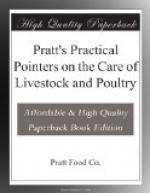The necessity for giving grain feed containing high percentage of digestible matter (known as concentrates) to dairy cows is based on the inability of the cow to consume and digest enough coarse fodders to result in maximum production, even though the fodders should be in balance as to their constituents.
Concentrates are purchased or home grown. It matters not from which source they are obtained, but the values of those purchased are becoming so high as to force upon dairy-men the necessity of growing them at home as far as this may be practicable, and of insuring sound digestion by giving some such tonic and appetizer as Pratts Cow Remedy. This splendid prescription should be kept on hand the year round, and should be given with every feeding, especially in winter. Its value in keeping up milk production and for maintaining health is unequalled.
The method of furnishing concentrates by growing certain of the small grains in combination is growing in favor. These combinations may include wheat, barley, outs, peas, and flax. Frequently but two varieties are grown together. They are grown thus, in the first place, to secure better yields, and, in the second, to furnish concentrates in approximate balance. Such a food, for instance, is obtained from growing wheat and oats together, and if some flax is grown in the mixture it will be further improved.
When choosing concentrates for feeding cows, the aim should be to select them so that when fed along with the roughage on hand, they will be in approximate balance, that is, the elements in them will best meet the needs of the cows.
If a flesh and milk-making food, like clover, is the source of the fodder, then a fat and heat-producing food, like corn, should furnish a large proportion of the grain fed. But it is not more profitable in all instances to feed foods in exact balance. Some of the factors may be so high priced and others so cheap that it will pay better to feed them more or less out of balance.
When good clover hay or alfalfa is being fed to cows in milk, any one of the following grain supplements will give satisfactory results.
(1) Corn meal and wheat bran, equal parts by weight.
(2) Corn meal, wheat bran, and ground oats in the proportions of 2, 1, and 1 parts.
(3) Corn meal, wheat bran, and cottonseed meal in the proportion of 2, 1, and 1 parts. Whether corn meal or corn and cob meals is fed is not very material. Barley meal may be fed instead of corn.
Should corn ensilage be fed to the extent of, say, 40 pounds per day along with clover or alfalfa, any one of the following grain supplements should suffice:
(1) Corn or barley meal, wheat bran, and ground oats, fed in equal parts by weight.
(2) Corn or barley meal and wheat bran, fed in the proportions of 1 and 2 parts.
(3) Corn or barley meal, cottonseed meal, and wheat or rice bran, fed in equal proportions.




